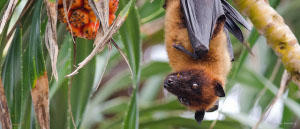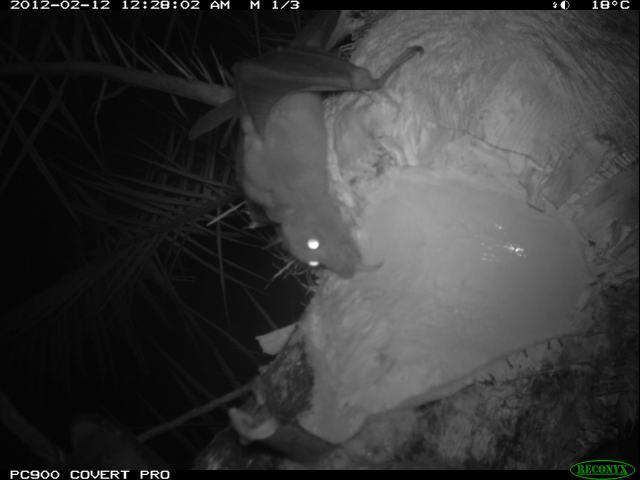On the Horizon: Nipah virus
Posted on August 23, 2016 by Benjamin Thompson
Our past two articles in the On the Horizon series have focused on diseases that were first identified decades ago. In this edition of the series, we’ll be looking at a virus that was only discovered at the very end of the 20th century, and the efforts being made to control it.

In late 1998, an outbreak of an unknown disease occurred in pigs and pig farmers in Kampung Sungai Nipah, a village in Malaysia.
The transporting of infected pigs also led to cases of the disease being identified 200 miles away in Singapore.
The outbreak caused almost 300 human cases and over 100 deaths were reported. Over a million pigs had to be destroyed at large economic cost to the region.
The causative agent of this disease has since been identified: a virus that was named Nipah, after the area it was discovered. Fruit bats are known to be the natural host and environmental reservoir for this virus.
To date, there have been no further outbreaks in Malaysia, but there have been several in Bangladesh and neighbouring areas of India. Nipah is a serious disease, causing often fatal inflammation of the brain; from 2001–2012 there were an estimated 280 cases of Nipah virus infection that resulted in 211 deaths, a 75% fatality rate. Currently, there is no vaccine, and those that survive an infection are at risk of permanent neurological issues.
Dr Emily Gurley, Director of the Programme for Emerging Infections at icddr,b, a research institute in Bangladesh, has been studying Nipah in the country since 2004. Her work, and that of her colleagues, uncovered the way the disease is transmitted in the country, which was initially a mystery. Unlike Malaysia, pork production is low in Bangladesh – so how was the virus managing to infect so many people?
“We thought that people must be getting it somehow directly from bats, but at first we really didn’t understand how,” she says. Some thorough epidemiological detective work from Emily’s team revealed a previously unknown route of viral transmission: date palm sap.
From October to March, sap harvesters known as gachhis climb to the top of date palm trees and shave off the bark into a ‘V’ shape, before inserting a spigot and allowing the sap to ooze overnight into a clay collection pot. This sap is drunk fresh and raw in the mornings, and is used to make molasses, or is sold in some cases as a fermented alcoholic drink (although this is taboo). The sap collection season also mirrors the times that Nipah virus cases are detected.
“We had one outbreak that was very clear – the people who had Nipah were much more likely to have drunk date palm sap [than those who didn’t].
“The path through the village where the local date palm seller went – all the cases traced that path. Sometimes you need multiple lines of evidence to wrap your head around a new mode of transmission. This one really looked like a smoking gun.”
But how was the virus getting into the sap? Unsurprisingly, humans aren’t the only ones who find raw sap delicious. Bats, often seen lapping at the trees, were a known problem for the gachhis; sap contaminated with bat faeces was understandably of much lower commercial value.
Mostly, the bats came out at night, so while they could be heard, they couldn’t always be seen. To understand how often they visited the trees, and what they were doing when they got there, required some night vision.
By mounting infrared motion-sensing cameras in the trees, Emily and her colleagues showed that the bats often cling onto the shaved area to lick the sap, and one was observed urinating from the tree. Research has shown that Nipah virus is detectable in both bat saliva and urine, making this a likely source for the viral contamination.

“These videos became extremely useful to communicate to the public that this is how you could be infected by a bat virus – and eliciting a bit of a disgust factor,” Emily says.
The Government of Bangladesh advises people to avoid drinking raw date sap, but, as with many things, abstinence isn’t always successful and many people still do, or are unaware of Nipah. Thankfully, there seems to be a relatively simple way to prevent the spread of the virus: stopping the bats getting to the sap. Some gachhis use bamboo skirts wrapped around the tree to protect their harvest – these skirts are inexpensive, don’t harm the bats, and are accepted by the harvesters themselves.
The team in Bangladesh set up two health interventions to see how levels of Nipah infection could be lowered. One contained messages about abstinence, while the second included both these messages and also promoted the use of the protective skirts.
“We recently completed a trial of the two intervention arms and a control,” Emily explains. “We saw a behaviour change over time. People still drank sap in all of the areas, but we saw reductions in the number of people reporting that they drank raw sap from unprotected trees.”
In addition to the date palm sap route, Nipah is also a virus that can be transmitted from person-to-person, which makes it an important pathogen to study, especially in a country as densely populated as Bangladesh. There is always the risk that a more transmissible strain could emerge, which would put serious strain on the health system of a country already facing competing public health problems, and potentially spread to neighbouring nations.
Having been identified less than 20 years ago, Nipah virus seems to be the definition of an emerging disease. But where has it come from? Emily suggests that it’s been around in Bangladesh for “a very long time”, but only with the relatively recent development of diagnostic testing was it able to be detected.
Aside from trying to instill behaviour change around sap consumption, the next step in preventing the disease is to develop a vaccine that could be used to protect people in the event of a bigger outbreak.
“You could vaccinate healthcare workers, which would have an impact on patient care,” Emily says. “Right now, rightly so, healthcare workers are afraid to treat patients with Nipah, so patient care suffers as a result. If we could help people to do their jobs more safely that would be useful.”
